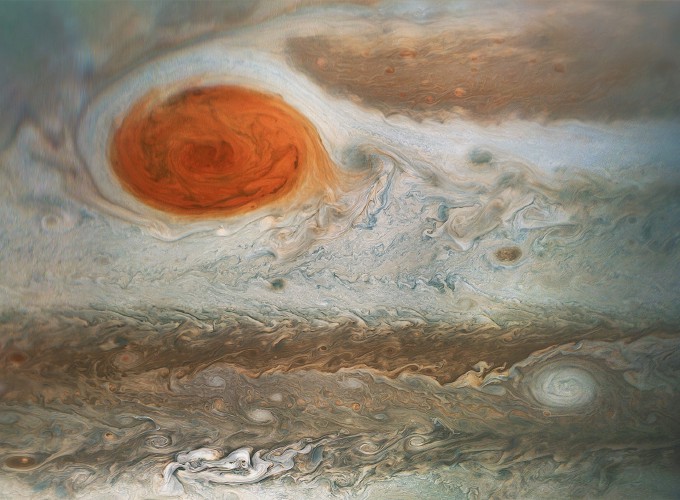The first work package of the GIANTCLIMES programme explores the atmospheric variability of Jupiter over long spans of time, combining data from Earth-based observatories with new observations from NASA’s Juno spacecraft. During the course of the ERC programme, the PI (Fletcher) was invited to serve as a Participating Scientist on the Juno mission, developing microwave capabilities for the NEMESIS software to explore the jovian atmosphere beneath the clouds. The Jupiter theme is supported by PDRAs Arrate Antunano (2017-Present) and Henrik Melin (2019-Present), alongside STFC-supported PhD student Padraig Donnelly. Notable projects as part of this work package include:
Exploration of cyclic variations in Jupiter’s troposphere: this included characterisation of the moist convective plumes responsible for the revival of Jupiter’s South Equatorial Belt in 2009-2011 (Fletcher et al., 2017, http://dx.doi.org/10.1016/j.icarus.2017.01.001), the 3-5 year cycle of expansion activity within Jupiter’s North Equatorial Belt (Fletcher et al., 2017, http://dx.doi.org/10.1002/2017GL073383), a review of cyclic activity across all of Jupiter’s main belts (Fletcher et al., 2017, http://dx.doi.org/10.1002/2017GL073806); the discovery of a cycle of equatorial disturbances responsible for periodically removing the clouds every 6-7 years (Antunano et al., 2018, https://doi.org/10.1029/2018GL080382); and a long-term study of Jupiter’s atmospheric variability from 1983 to the present day (Antunano et al., 2019, https://doi.org/10.3847/1538-3881/ab2cd6). Ongoing work involves the extension of these studies to other wavelength ranges, and further characterisation of the newly-discovered equatorial disturbance. In 2018, the team produced a series of papers (https://doi.org/10.3847/1538-3881/aace02, https://doi.org/10.3847/1538-3881/aacaf5) using Juno, Hubble, and ground-based data to characterise newly-discovered waves in the atmosphere, which could be linked to these long-term cycles and the formation of cyclones. Fletcher recently submitted a large-scale review paper (https://arxiv.org/abs/1907.01822) on Jupiter’s banded structure to Space Science Reviews, asking how much we really understand about the belts and zones of giant planets.
Exploration of atmospheric cycles in Jupiter’s stratosphere: PDRA Melin published a study using the mid-infrared TEXES spectrometer on NASA’s Infrared Telescope Facility, expanding on our previous work mapping Jupiter’s temperatures, clouds and composition on a single date (http://dx.doi.org/10.1016/j.icarus.2016.06.008) to understand the variations of stratospheric hydrocarbons over half a jovian year (https://doi.org/10.1016/j.icarus.2017.12.041). This same instrument was used by Dr. Richard Cosentino (Collaborator at Goddard Spaceflight Center) to understand Jupiter’s Quasi-Quadrennial Oscillation (https://dx.doi.org/10.1002/2017JE005342), and we are presently following up this study to explore whether the QQO is in fact variable with time, responding to forcing from the deeper atmosphere. We are also extending this study into the ultraviolet: PDRA Melin has added the necessary capabilities to our NEMESIS tool (a test of the new UV modelling procedure has been applied to Cassini/UVIS data and submitted for publication in October 2019), and will begin applying this to long-term records of UV observations of Jupiter.
Ground-Based Observing Campaign: As part of Fletcher’s role as Juno Participating Scientist, and as members of the supporting team for Juno, the team continues to observe Jupiter’s atmosphere using the Very Large Telescope (VLT) in Chile and NASA’s Infrared Telescope Facility (IRTF) in Hawaii. Fletcher and Donnelly had a successful visitor-mode run at the VLT in May 2018 that coincided perfectly with Juno’s 13th perijove. High-resolution thermal maps of Jupiter were presented at the DPS meeting in 2018 and are being prepared for publication as part of the PhD thesis of Donnelly. Antunano has visited the IRTF for training for TEXES observations. In order to support the connection between Juno and the Earth-based community, Fletcher co-organised (with Dr. John Rogers of the British Astronomical Association) a Europlanet-funded workshop at the Royal Astronomical Society in London to bring together members of the Juno team with professional and amateur astronomers exploring atmospheric variability on Jupiter. Finally, the GIANTCLIMES team have been collaborating with Imke de Pater and colleagues in Berkeley, using both the VLA (https://doi.org/10.1016/j.icarus.2018.11.024) and ALMA (https://doi.org/10.3847/1538-3881/ab3643) arrays to probe ammonia at high pressures in the microwave regime, as a precursor to Fletcher’s work with Juno data.
Space-Based Observations: Guaranteed-time observations of Jupiter’s Great Red Spot (programme ID 1246) using the James Webb Space Telescope (JWST) have been awarded and prepared for execution in the first year of operations. Fletcher and Melin are also part of an Early-Release Science team for observations of Jupiter’s Great Red Spot and polar auroras, with key new discoveries expected in 2021-22.
